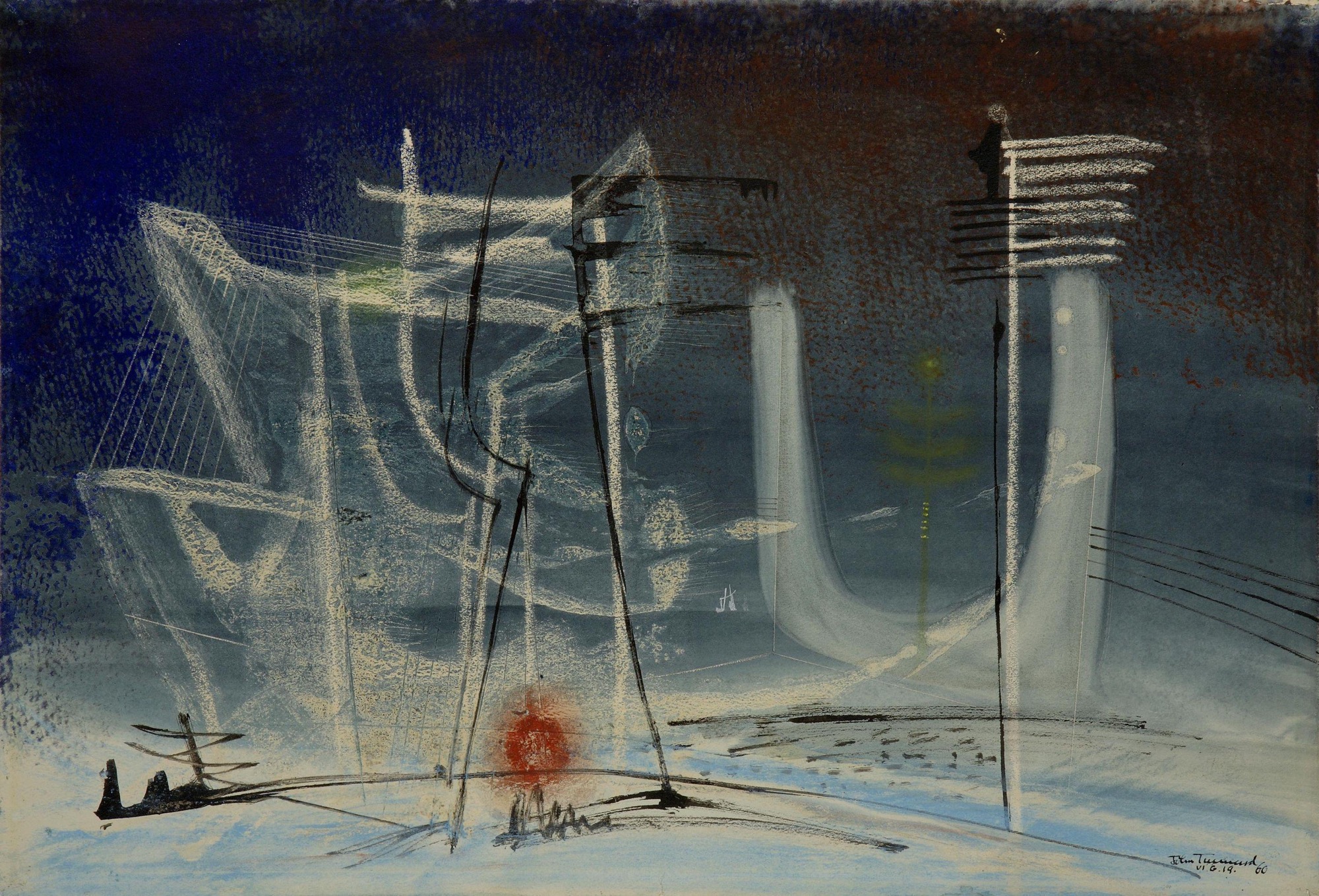66º32 North
10734
John Tunnard A.R.A. (British, 1900-1971)
66º32 North
signed and dated 'John Tunnard/VI.G.19. 60' (lower right)
watercolour, pastel, brush and ink
37 x 54.5 cm. (14 1/2 x 21 1/2 in.)
Tunnard's painting enjoyed a rise in popularity after the McRoberts and Tunnard Gallery one man exhibition in 1959. During 1960, when the present work was executed and partly due to his friend Vivian Pitchforth, Tunnard was inspired to begin exhibiting at the Royal Academy again which he had not done since 1931. The title of 66º32 North signifies the latitude of the Arctic Circle.
20th Century
1950
British
McRoberts and Tunnard, London, 12 September 1960 The Belgrave Gallery, London Anonymous sale; Christie's, London, 8 March 1991, lot 124
A. Peat and B.A. Whitton, John Tunnard His Life and Work, Scolar Press, Aldershot, 1997, p.195, no.771 JOHN TUNNARD, A.R.A. (British, 1900-1971) John Tunnard was born in Bedfordshire, and educated at Charterhouse School. He studied design at the Royal College of Art (1919-1923). In the 1920s he worked in various textile design jobs in Manchester. He took up painting seriously in 1928, and taught design at the Central School of Arts and Crafts, London, from 1929. The techniques that Tunnard used evolved from these early days as a commercial designer. He wanted to command a full understanding of all the essential qualities of painting; form, colour, texture etc. Compositions were always meticulously executed. He carefully rendered shapes applying clear, precise edges; indeed, with scientific precision; he often used a compass and a ruler. His choice of materials was sometimes unusual; gouache or oil on a gesso base were his favoured materials, but he often used a range of media for a single work. For example; in many of his paintings tempera and oil paint were combined on the picture surfaces. Tunnard's early works were fairly conventional. In 1931 he exhibited at the Royal Academy and with the London Group, which he joined in 1934. His first major exhibition, held in 1932 at the Redfern Gallery, featured landscapes, marine scenes and still life. In 1933 the Tunnards moved to Cornwall, where they ran a business making printed silks but increasingly he focused on painting. From the mid-1930s, he became friends with Julian Trevelyan, Henry Moore, John Betjeman and Humphrey Spender. Tunnard began to paint abstract works influenced by the styles of Joan Miró and Paul Klee, and further embraced British surrealism on reading Herbert Read's Surrealism. Tunnard began at this time to revive his early interest in natural science, collecting entomological specimens on the moors for the British Museum of Natural History and observing the minutiae of nature that provided a source of imagery for his art. His works featured architectural and biomorphic forms combined with elements of constructivism reflecting his interest in the technology of space travel. In his Self Portrait ( National Portrait Gallery) the artist depicts himself alongside an oversized insect. Although he never formally joined the Surrealist movement, Tunnard participated in several of the group's exhibitions in the 1930s, including 'Surrealism', held c.1937 at Gordon Fraser Gallery in Cambridge, which featured works by Max Ernst, Klee, Magritte, Miró and others. In March 1939 Peggy Guggenheim gave Tunnard a show at her gallery Guggenheim Jeune in London. He was a conscientious objector in World War II, working briefly as fisherman in 1939, then as an auxiliary coastguard in 1940 for the duration of the war. During this period he participated in group shows in London at the Redfern Gallery, the Zwemmer Gallery, Alex Reid and Lefevre. The British Council included his work in three survey exhibitions in Australia and South America between 1940 and 1949. In 1944 the artist was given a one-man show at the Nierendorf Gallery in New York. Tunnard was highly productive in the immediate post-war years. He resumed teaching design in 1946 at Wellington College, Berkshire, and two years later at Penzance School of Art, Cornwall. Also in 1946 he was featured in 'Contemporary British Art,' which travelled to the Toledo Museum of Art, Ohio, the Albright Art Gallery, Buffalo, and the City Art Museum, St Louis. In 1949 his work was shown at the Salon des Réalités Nouvelles in Paris. He exhibited at the 1951 Festival of Britain where, with Victor Pasmore and Ben Nicholson, he was also commissioned to paint a large mural for the festival buildings. In 1952 he showed at Durlacher Brothers in New York, where he would have a solo exhibition in 1960. There were many successful exhibitions including several at the McRoberts & Tunnard Gallery. Tunnard was elected an associate of the Royal Academy in 1967. In 1971 he was represented in 'The British Contribution to Surrealism' at Hamet Gallery in London. The artist died 18th December 1971. <
Commemorative













